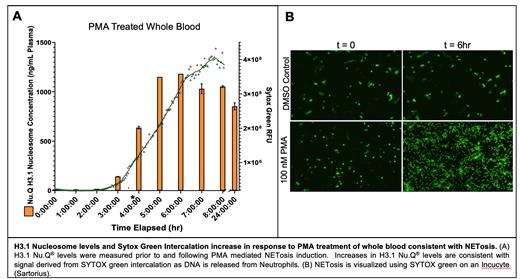Sepsis is a leading cause of death, affecting 1.7 million adults annually in the US, where it is implicated in ~350,000 deaths (1). Rapid recognition and intervention are required to avoid progression to septic shock and death. Sepsis results from a dysregulated host response to infection (2). We aimed to study part of this dysregulated response by analyzing NETosis in neutrophils. Neutrophils are integral to the innate immune response. They can undergo a unique type of programmed cell death, NETosis, where nuclear chromatin is extruded out of the cell to capture and deactivate pathogens and prevent dissemination. These neutrophil extracellular traps (NETs) contain nucleosomes, DNA and histone proteins. NETs help to trap invading pathogens but in excess, lead to endothelial damage, excessive activation of platelets and promote microthrombosis in distal organs leading to organ failure. Our understanding of NETosis largely stems from mouse models, immortalized cell lines, and isolated neutrophils. However, these don't entirely mirror the complexity of human immune response. Here we present a model of ex vivo NETosis induction in whole blood, which can be used to provide greater clarity on the complex signaling and chromatin changes associated with NETosis.
We developed an ex vivo Synthetic Sepsis TM model for observing induced NETosis in whole blood. Whole blood from healthy volunteers was induced with Phorbol 12-myristate 13-acetate (PMA), Calcium Ionophore (CI) or Lipopolysaccharides (LPS) and NETosis was monitored using H3.1 Nu.Q® levels. In parallel we adapted a SpectraMax plate reader for whole-blood fluorescent readings via Sytox Green interacalation to measure DNA release associated with NETosis. Neutrophils were isolated using the MACSxpress® Whole Blood Neutrophil Isolation Kit and NETosis of isolated neutrophils was visualized using the Incucyte® system from Sartorius. A myeloperoxidase (MPO) inhibitor, ABAH, was used to assess NETosis inhibition in PMA-induced isolated neutrophils, which allowed us to detect a reduction in both nucleosome levels using our H3.1 Nu.Q® assay and the measured DNA release via real-time fluorescence techniques. We next compared the NETosis profiles in our ex vivo Synthetic Sepsis TM model with isolated neutrophils to assess the impact of other blood cells and circulating proteins. Further, Methylation analysis post-ONT sequencing facilitated cell of origin analysis.
H3.1 Nu.Q® levels increased with NETosis induction, consistent with DNA release as measured by Sytox green. NETosis was detected 1.5 hours after PMA induction using H3.1 Nu.Q® and Sytox assays. DNA Methylation analysis confirmed neutrophil cell of origin post induction. MPO inhibition resulted delayed onset of NETosis, supporting NET release rather than other forms of cell death. Netosis visualization using microscopy confirmed NETosis. Importantly, we found that although PMA successfully induced NETosis in both contexts, CI failed to elicit a response in the ex vivo whole bloodsystem, highlighting the importance of a full blood model for unbiased NETosis profiling.
Our findings demonstrate that H3.1 nucleosome levels are elevated in response to NETosis-inducing treatments, with a time course that is consistent with NETosis and correlates with other established NETosis markers, validating its utility as a reliable indicator of NETosis. The successful induction of NETosis in an ex vivo whole blood model provides a valuable tool for studying disease-associated NETosis within a biologically relevant context, which will likely shed additional insight which is not possible using isolated neutrophils. Utilizing these approaches provides a platform to scrutinize a wide array of both synthetic and naturally occurring NETosis regulators. It facilitates insight into the signalling mechanisms at the core of NETosis and the influence of chromatin-associated changes within an in vivo like microenvironment of whole blood. By unravelling the intricate dynamics of neutrophil biology and its interplay with the microenvironment, we can develop tailored interventions to modulate NETosis in sepsis and other inflammatory conditions.
1. https://www.cdc.gov/sepsis/index.html.
2. Singer M, Deutschman CS, Seymour CW, Shankar-Hari M, Annane D, Bauer M, et al. The Third International Consensus Definitions for Sepsis and Septic Shock (Sepsis-3). JAMA. 2016 Feb 23;315(8):801.
Disclosures
Cayford:Volition America: Current Employment, Current equity holder in publicly-traded company. Eccleston:Belgian Volition: Consultancy. Berman:Volition Singapore: Consultancy. Serneo:Volition America: Current Employment. Kelly:Volition America: Current Employment, Current equity holder in publicly-traded company. Retter:Volition America: Consultancy. Zukas:Volition America: Current Employment.


This feature is available to Subscribers Only
Sign In or Create an Account Close Modal